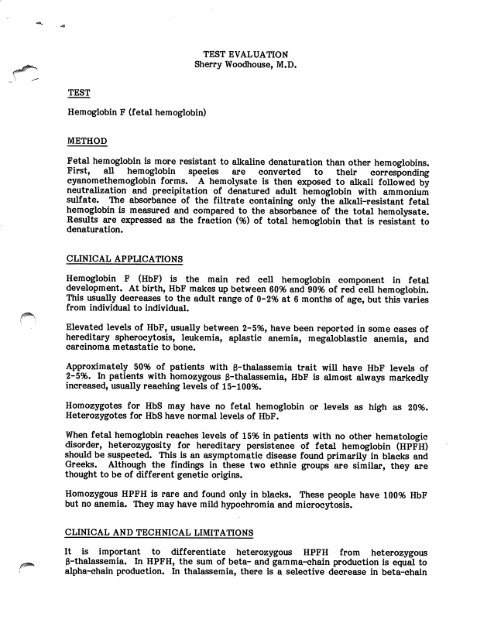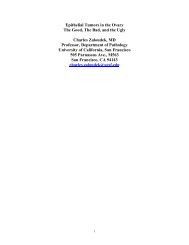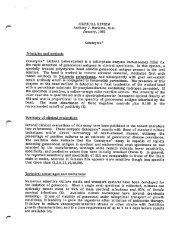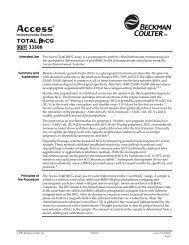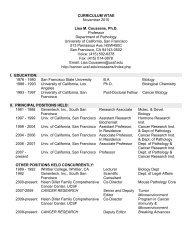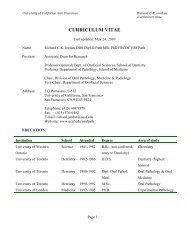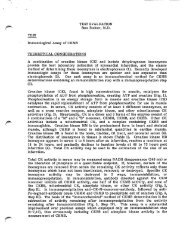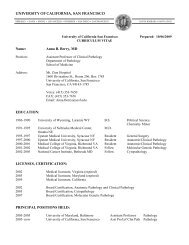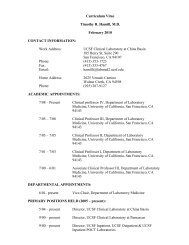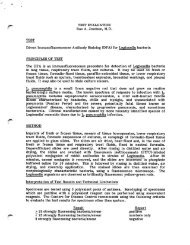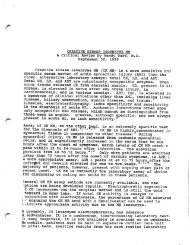Hemoglobin F (fetal hemoglobin)
Hemoglobin F (fetal hemoglobin)
Hemoglobin F (fetal hemoglobin)
Create successful ePaper yourself
Turn your PDF publications into a flip-book with our unique Google optimized e-Paper software.
jlf^sk^y<br />
TEST<br />
<strong>Hemoglobin</strong> F (<strong>fetal</strong> <strong>hemoglobin</strong>)<br />
METHOD<br />
TEST EVALUATION<br />
Sherry Woodhouse, M.D.<br />
Fetal <strong>hemoglobin</strong> is more resistant to alkaline denaturation than other <strong>hemoglobin</strong>s.<br />
First, all <strong>hemoglobin</strong> species are converted to their corresponding<br />
cyanomet<strong>hemoglobin</strong> forms. A hemolysate is then exposed to alkali followed by<br />
neutralization and precipitation of denatured adult <strong>hemoglobin</strong> with ammonium<br />
sulfate. The absdrbance of the filtrate containing only the alkali-resistant <strong>fetal</strong><br />
<strong>hemoglobin</strong> is measured and compared to the absorbance of the total hemolysate.<br />
Results are expressed as the fraction (%) of total <strong>hemoglobin</strong> that is resistant to<br />
denaturation.<br />
CLINICAL APPLICATIONS<br />
<strong>Hemoglobin</strong> F (HbF) is the main red cell <strong>hemoglobin</strong> component in <strong>fetal</strong><br />
development. At birth, HbF makes up between 60% and 90% of red cell <strong>hemoglobin</strong>.<br />
This usually decreases to the adult range of 0-2% at 6 months of age, but this varies<br />
from individual to individual.<br />
Elevated levels of HbF, usually between 2-5%, have been reported in some cases of<br />
hereditary spherocytosis, leukemia, aplastic anemia, megaloblastic anemia, and<br />
carcinoma metastatic to bone.<br />
Approximately 50% of patients with 3-thalassemia trait will have HbF levels of<br />
2-5%. In patients with homozygous g-thalassemia, HbF is almost always markedly<br />
increased, usually reaching levels of 15-100%.<br />
Homozygotes for HbS may have no <strong>fetal</strong> <strong>hemoglobin</strong> or levels as high as 20%.<br />
Heterozygotes for HbS have normal levels of HbF.<br />
When <strong>fetal</strong> <strong>hemoglobin</strong> reaches levels of 15% in patients with no other hematologic<br />
disorder, heterozygosity for hereditary persistence of <strong>fetal</strong> <strong>hemoglobin</strong> (HPFH)<br />
should be suspected. This is an asymptomatic disease found primarily in blacks and<br />
Greeks. Although the findings in these two ethnic groups are similar, they are<br />
thought to be of different genetic origins.<br />
Homozygous HPFH is rare and found only in blacks. These people have 100% HbF<br />
but no anemia. They may have mild hypochromia and microcytosis.<br />
CLINICAL AND TECHNICAL LIMITATIONS<br />
It is important to differentiate heterozygous HPFH from heterozygous<br />
3-thalassemia. In HPFH, the sum of beta- and gamma-chain production is equal to<br />
alpha-chain production. In thalassemia, there is a selective decrease in beta-chain
Page 2<br />
synthesis and an associated hypochromia and mieroeytosis. HbF is evenly<br />
distributed among all red cells in HPHF. In thalassemia, HbF is heterogeneouslv<br />
distributed. This can be determined by a Kleihauer-Betke test. <strong>Hemoglobin</strong> F is<br />
precipitated and fixed in red blood cells on a peripheral smear. Homogeneous versus<br />
heterogeneous red cell populations can be determined.<br />
The alkali denaturation method is fast and easy to perform. A significant<br />
disadvantage is that HbF is not entirely resistant to alkaline denaturation and can be<br />
underestimated by this method.<br />
Another potential problem is that HbF may be absorbed by filter paper during<br />
filtration. Choice of an appropriate grade of filter paper may minimize this<br />
problem.<br />
Other methods for measuring <strong>fetal</strong> <strong>hemoglobin</strong> include column chromatography,<br />
radioimmunoassay, an enzyme-linked immunoabsorbent assay (ELISA) and radial<br />
immunodiffusion.<br />
REFERENCES<br />
1. International Committee for Standardization in Haematology.<br />
Recommendations for <strong>fetal</strong> <strong>hemoglobin</strong> reference preparations and <strong>fetal</strong><br />
haemoglobin determination by the alkali denaturation method. Br J Haematol<br />
/&*• 42:133-136, 1979.<br />
2. Molden DP, et al: Fetal <strong>hemoglobin</strong>: optimum conditions for its estimation by<br />
alkali denaturation. Am J Clin Pathol 77:568-572, 1982.


